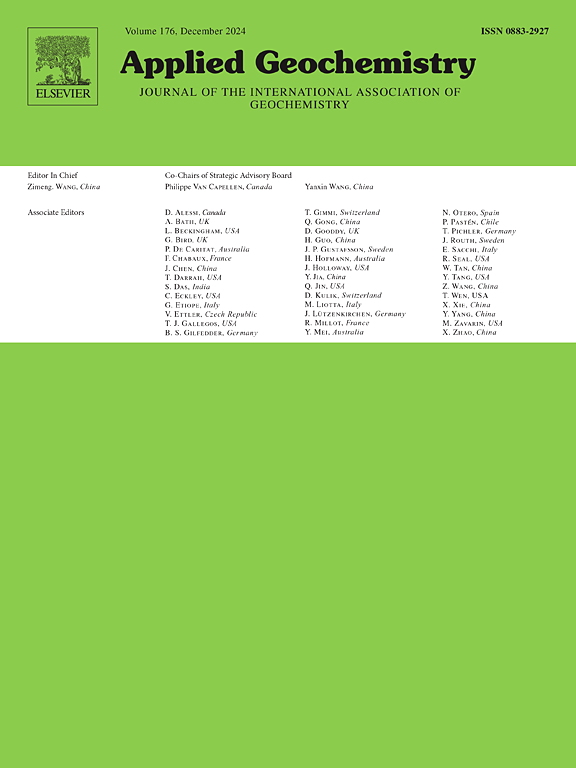在广泛的气候条件下,土壤溶解有机质的分子组成受活性矿物相关有机质的调节
IF 3.1
3区 地球科学
Q1 GEOCHEMISTRY & GEOPHYSICS
引用次数: 0
摘要
活性矿物所保留的有机质是碳在土壤中长期储存的重要机制,这一过程受气候因素的支配。然而,活性矿物相关有机质如何在广泛的气候范围内影响土壤溶解有机质(DOM)的组成仍不清楚。本研究采用化学萃取法测定了活性矿物及其伴生有机质的含量。此外,通过傅立叶变换离子回旋共振质谱、固态13C核磁共振和统计分析,在分子水平上研究了活性矿物保留的有机质对土壤DOM组成的影响。FT-ICR-MS和相关分析结果表明,随着活性矿物单位质量(OC)RN)有机质含量的增加,土壤中碳水化合物和蛋白质/氨基糖的相对丰度降低,而凝聚芳烃的相对丰度增加。我们强调DOM分子,特别是芳香分子在活性矿物上的吸附和溶解过程对土壤溶液中DOM分子组成的调节起着至关重要的作用。(OC)RN受气候驱动的化学风化(如降水)控制。研究结果表明,(OC)RN是气候影响下调节土壤DOM组成的关键变量,可用于建立碳循环预测模型。本文章由计算机程序翻译,如有差异,请以英文原文为准。
The molecular composition of soil dissolved organic matter regulated by reactive mineral-associated organic matter under a broad range of climates
Organic matter retained by reactive minerals constitutes an essential mechanism for long-term storage of carbon in soil, a process that is governed by climate factors. However, how the reactive mineral-associated organic matter affects the composition of soil dissolved organic matter (DOM) across a broad range of climates remains unclear. In this study, the contents of reactive minerals and their associated organic matter were determined by the chemical extraction method. Moreover, the effects of organic matter retained by reactive minerals on soil DOM composition were investigated at molecular level across a wide environmental gradient, by employing Fourier transform ion cyclotron resonance mass spectrometry, solid-state 13C nuclear magnetic resonance and statistical analyses. The results of FT-ICR-MS and correlation analyses indicated that the relative abundances of carbohydrates and proteins/amino sugars decreased, while the relative abundance of condensed aromatics increased with the increase of the content of organic matter retained by reactive minerals per unit mass (i.e., (OC)RN) in soils. We highlighted that the adsorption and dissolution processes of DOM molecules, especially aromatic molecules, on reactive minerals played crucial roles in regulating the molecular composition of DOM in soil solution. Furthermore, (OC)RN was controlled by climate-driven chemical weathering (e.g., precipitation). Our results imply that (OC)RN is a key variable for regulating soil DOM composition under the impacts of climates, and can be used in developing prediction models for carbon cycling.
求助全文
通过发布文献求助,成功后即可免费获取论文全文。
去求助
来源期刊

Applied Geochemistry
地学-地球化学与地球物理
CiteScore
6.10
自引率
8.80%
发文量
272
审稿时长
65 days
期刊介绍:
Applied Geochemistry is an international journal devoted to publication of original research papers, rapid research communications and selected review papers in geochemistry and urban geochemistry which have some practical application to an aspect of human endeavour, such as the preservation of the environment, health, waste disposal and the search for resources. Papers on applications of inorganic, organic and isotope geochemistry and geochemical processes are therefore welcome provided they meet the main criterion. Spatial and temporal monitoring case studies are only of interest to our international readership if they present new ideas of broad application.
Topics covered include: (1) Environmental geochemistry (including natural and anthropogenic aspects, and protection and remediation strategies); (2) Hydrogeochemistry (surface and groundwater); (3) Medical (urban) geochemistry; (4) The search for energy resources (in particular unconventional oil and gas or emerging metal resources); (5) Energy exploitation (in particular geothermal energy and CCS); (6) Upgrading of energy and mineral resources where there is a direct geochemical application; and (7) Waste disposal, including nuclear waste disposal.
 求助内容:
求助内容: 应助结果提醒方式:
应助结果提醒方式:


